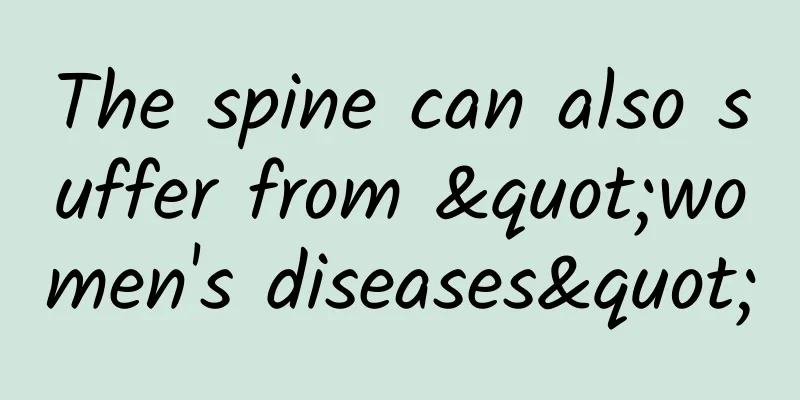The spine can also suffer from "women's diseases"

|
This is the 3085th article of Da Yi Xiao Hu Case sharing: Case 1: Aunt Wang, who lives in Pudong, developed back pain after bending over to move boxes on the floor 10 days ago. She could not straighten her back and it hurt when she turned over in bed. Thinking she had sprained her waist, she applied a plaster and rested for a few days but there was no improvement. So her family sent Aunt Wang to a traditional Chinese medicine clinic for acupuncture and massage, but the symptoms did not ease. Case 2: Granny Li, who lives in Xuhui, had chest and back pain after sneezing two weeks ago. The pain worsened after activity and was slightly relieved when lying flat. She did not take it seriously at the time and took Chinese medicine on her own, but the symptoms did not improve and her daily life was seriously affected. Treatment process: Aunt Wang and Granny Li were introduced to the Department of Spine Surgery of Zhongshan Hospital Affiliated to Fudan University in Shanghai. Director Dong Jian carefully inquired about the patient's medical history and combined with relevant physical examinations, highly suspected that Aunt Wang and Granny Li had "osteoporotic vertebral compression fractures". After the fracture was confirmed by magnetic resonance imaging, minimally invasive percutaneous vertebroplasty was performed. After the operation, Aunt Wang and Granny Li's pain was significantly relieved, and they were able to walk on the second day. Both were discharged from the hospital within 2 days after the operation. In the above two cases, both patients suffered osteoporotic vertebral compression fractures. Why did they fracture even if they fell? Why were both patients female? Is this really a coincidence? Let us learn more about it! 1. What is osteoporotic vertebral compression fracture? Osteoporosis is a degenerative, progressive disease that causes bones to become weak and prone to fractures. Fractures are usually not noticed before they occur, and fractures can occur with minimal external force, most commonly in the spine, hips, and wrists. Half of osteoporotic fractures occur in the vertebral bodies of the spine, and they often occur in postmenopausal women, so some people call it "the women's disease of the spine." These patients experience back pain, hunchback deformity, and reduced height, which can even affect their daily lives and seriously affect their quality of life. 2. Why are osteoporotic vertebral compression fractures more likely to occur in menopausal women? The prevalence of osteoporosis and related fractures in postmenopausal women is much higher than that in elderly men. In postmenopausal women, due to estrogen deficiency, bone mass decreases and bone tissue structure changes, which increases bone brittleness and makes them prone to fractures. It has been confirmed that estrogen plays an important role in the growth and development of women's bones. It can store calcium in the bones. The reduction of estrogen makes the storage capacity lower than the loss rate. The closer to menopause, the faster the loss, and once menopause, the loss is even faster. The fastest and most calcium loss in women's bones is the first to seventh years after menopause, so this stage is a critical period for women to supplement calcium. At the same time, it is recommended that menopausal women come to the hospital for DXA (dual-energy X-ray bone density measurement) examination to understand their bone density and prevent and treat osteoporosis as early as possible. 3. How to treat osteoporotic vertebral compression fractures Treatments for this disease include conservative treatment and surgical treatment. Traditional treatment methods include bed rest, oral analgesics, and the use of calcitonin to relieve bone pain. Most patients can get relief from pain symptoms, but long-term bed rest is a painful thing. In severe cases, turning over in bed can cause pain, and can also lead to aggravated osteoporosis and complications such as bedsores and deep vein thrombosis of the lower limbs. For this type of osteoporotic vertebral compression fracture, there is a good minimally invasive treatment method, which is percutaneous vertebral augmentation (PVA). It has little trauma and good analgesic effect, allowing patients to resume daily activities as soon as possible and greatly improve their quality of life. PVA mainly includes percutaneous vertebroplasty (PVP) and percutaneous kyphoplasty (PKP). Simply put, PVA is to inject a shot of "bone cement" on the back of the lesion compressed vertebra to prop up the vertebra to restore height and hardness, so as to relieve pain and achieve the purpose of early activity. 4.How to prevent osteoporotic vertebral compression fractures? Osteoporosis is also known as the "silent killer." We don't feel our bones deteriorating until they break and then we feel pain. Instead of waiting for fractures to occur, it is better to take the initiative and prevent osteoporosis in advance. Starting from adolescence, we should strengthen physical exercise and ensure adequate calcium intake. At the same time, we should actively screen and treat various diseases that cause digestion, malabsorption, and endocrine dysfunction; avoid long-term use of drugs that affect bone metabolism, etc., try to obtain the ideal peak bone mass, obtain more bone reserves, and reduce the risk of osteoporosis in the future. The bone mass of people aged 30-35 reaches its peak, and then begins to gradually decrease. If you do not take measures to reduce the rate of bone loss, you will suffer from osteoporosis earlier. The basic measures are to maintain good living habits, a balanced diet, adequate intake of calcium and vitamin D, and a certain amount of outdoor activities and exercise. Women should evaluate their bone density as soon as possible after menopause, and decide when to start anti-osteoporosis treatment based on whether osteoporotic fractures have occurred in the bone density examination. If you have already suffered from osteoporosis, in addition to maintaining appropriate exercise and standardized anti-osteoporosis treatment, you must also avoid all kinds of falls and trauma to avoid fractures. Author: Hu Zhichao and Li Juan Instructor: Dong Jian Unit: Department of Orthopedics, Zhongshan Hospital Affiliated to Fudan University Institute of Medical Science Popularization, Fudan University This article was funded by the following project: Shanghai Science and Technology Commission Science Popularization Project (No.: 20DZ2312000) Shanghai Municipal Health Commission Outstanding Academic Leader Project (No.: GWV-10.2-XD11) |
<<: A contemplative summary of the "seven-year itch" of ground-glass nodules in the lungs (finale)
>>: What are the benefits of Tsingtao Beer to the body? How many series does Tsingtao Beer have?
Recommend
I gained 2 catties in 6 days by taking Chinese medicine for regulating menstruation
Women's menstrual period is a special functio...
What is the normal hcg value for women?
There are many ways to check whether a woman is p...
Attention! It is not advisable to get the flu vaccine in these cases
Seasonal influenza is an acute viral infection th...
It became a hot search! Some people panicked when they saw it! The truth is revealed
These two days Topic #A black line suddenly grew ...
The best time to do a cervical smear
Cervical smear is one of the examination methods ...
Correct sleeping position for the first three days after transplantation
The most difficult part of doing IVF is not the p...
Medical abortion is considered clean after 25 days
Medical abortion is a very convenient, but also v...
Menstrual symptoms before menopause, 3 signs to watch out for
Women will experience a series of changes in thei...
The uglier these 8 parts of a woman are, the healthier she is
Big butt means good cardiovascular health In the ...
What happens if a pregnant woman stands for a long time?
We all know that the physical condition of pregna...
Postpartum hemorrhage signs
There are several main reasons for postpartum hem...
What to do if you have pain in accessory breast
Having accessory breasts may cause pain, which is...
Placenta anterior uterine wall male and female
The gender of the baby in the belly has always be...
Is it meaningful to check the chromosomes of the embryo?
Pregnancy is a particularly important thing for w...
eMarketer: Survey on smartphone penetration in Asia Pacific
199IT original compilation The iPhone may be numb...









